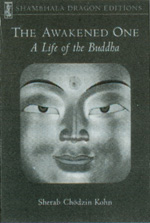Shambhala Publications: Boston and London, 1994.
172 pp., $8.00 (paper).

As a student of Buddhism I have often wondered why a readable and intelligent “life of the Buddha” did not exist. There are indeed numerous translations, anthologies, and secondary sources that include the relevant materials for presenting a “life” of the Buddha, but for various reasons these works are not completely suitable for a serious but average audience. Books that present a “life” of the Buddha tend toward two extremes. The pioneering translations of Pali texts and the early twentieth-century studies of the Buddha’s life are highly dependable in terms of scholarship, but are written in a Victorian language and idiom, or at best, affect a stiff Edwardian posture that is difficult for modern readers to penetrate. In response to the now awkward English of these early attempts, a new genre in Buddhist literature has appeared, a type which could politely be termed a “reconstruction” (but ought to be recognized more truthfully as a “rehash”) of the first work in Buddhology. There is nothing inherently wrong with the motive or the idea of a reconstruction or recomposition of materials presented by great scholars, thinkers, and writers such as Hermann Oldenberg, the Rhys Davids, E. J. Thomas, or Coomaraswamy, but these “reconstructions” frequently tend toward a colloquial, superficial, and decidedly anti-academic presentation. A middle path seems to be lacking.
The back cover of the advance copy of The Awakened One suggests that the book is a “fresh” and “modern retelling” of one of “the world’s great spiritual biographies.” Unfortunately, I was hard-pressed to discover anything in Kohn’s attempt that was “fresh” or seemed “modern.” Instead, The Awakened One seems clearly to fall into the extreme of rehashing the older, more solid and respectable efforts. Kohn likens his approach to that of a composer who has tried to preserve in a single “unified chamber piece” the essence and integrity of an ancient “manifold song cycle.”
But for a self-professed “retelling,” the language, tone, and composition of The Awakened One seem anything but modern, retaining a very stilted and awkward veneer: “gaily caparisoned teams of oxen” inaugurate the planting season; old age, sickness, and death are “profound vexations”; nirvana is the “undefiled supreme surcease of bondage”; and the Prince’s attendants sleep in “ungainly postures.” The “sorrows and limitations” (to borrow another phrase from the book) of this newest version of the life of the Buddha are all too familiar. Despite Kohn’s intentions, the Buddha remains a perfect Edwardian gentleman.
One of the more frustrating aspects of the book is its lack of annotation. I often wanted to know where Kohn had gotten his particular version of an event in the Buddha’s life, which translation he was relying on at a certain point, or why he had adapted translations in an odd way. Three pages of introduction and one page of notes seem woefully inadequate. And there are some rather blatant errors in the text: I was especially stumped by a statement early in the text that the Buddha’s “final birth” (the historical Buddha’s birth, no doubt) was in the third millennium B.C.E.
Nevertheless, the appearance of both The Awakened One and Bernardo Bertolucci’s forthcoming film Little Buddhadoes bring to mind several interesting problems in connection to producing some kind of biography of the Buddha. Despite what Kohn calls the “large and complex body of materials on the Buddha’s life,” the actual deeds, details, and facts are terrifically scant. Anyone who seeks a biography in the modern sense of the genre can only be greatly disappointed. And indeed, the situation seems to be similar to that of many spiritual masters: what is known of Moses, Socrates, or Jesus—especially compared with the life of, say, Madonna or Sigmund Freud? The difference is defined not so much by a modern world with increased reportage and information, but, rather, by the significant redefinition of what signifies a “life” and what is significant in that life: the usual and unusual political, economic, and societal events that crowd a person’s life would presumably be given very little weight in a biography by or about a buddha. On the other hand, the biography of a Buddha might be expected to recall certain events of being and becoming, but those events and struggles are often wrapped in a symbolic language, what Buddhists call a “twilight language,” which is meant to evoke the sense of presence that can emerge only when one exists in the moment, in-between. In that way, a “life” of the Buddha, regardless of the formal approach that is adopted, will be successful to the extent that the retelling allows the mystery, depth, and dignity of an unknown world to emerge—a world that will not emerge from the text as a known “thing” or object, but as a question or a presence between two worlds, between two states, between the extremes of the known and the unknown. Someone might argue that this is almost impossible, that the demand is unfair or too great. But that, I would argue, is just the point: it would be better not to write at all than to write without feeling the challenge, weight, brilliance, dignity, and possibility that the Buddha’s “life” can evoke.